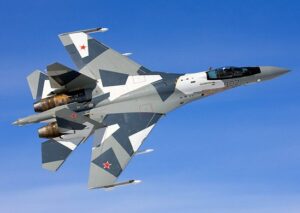 |
| Su-35 |
The Russian Sukhoi Su-35’s performance in the ongoing conflict has been the subject of scrutiny, with varied results. The Su-35, which was initially deployed as a critical asset for air superiority and support missions, has faced major challenges against Western advanced air defense systems, such as Patriot missiles supplied by the United States. The latest conflict has resulted in the loss of at least seven Sukhoi Su-35 fighter aircraft. A variety of factors have been identified as the cause of the losses. Only two are acknowledged as the result of hostile action. Non-combat factors, including mechanical malfunctions, accidents, or other operational issues, may be responsible for the remaining losses.
The Sukhoi Su-35, a multirole air superiority fighter that was developed from the Su-27, comprises the Su-35BM and the Su-35SM, which are the most recent variants.
Known as “Bolshaya modernizatsiya” (big modernization), the Su-35BM is a sophisticated version that prioritizes improved capabilities for multirole missions and air superiority. First unveiled in 2007, the Su-35BM began production as the Su-35S in 2010. This variant stands out by its sophisticated weapon systems, high maneuverability (+9g), and a modernized airframe that integrates technologies from fifth-generation fighters such as the Su-57. It is capable of simultaneously engaging multiple targets and has a radar detection range of up to 350 km.
An ongoing modernization initiative aims to enhance the capabilities of the current fleet, resulting in the Su-35SM. New technologies and systems that are derived from the Su-57 program are anticipated to be incorporated. Some of the expected improvements are the addition of more advanced weapons like the R-37M and R-77M missiles, a new active electronically scanned array (AESA) radar to replace the older Irbis-E radar and better electronic warfare capabilities. This variant aims to maintain its effectiveness against the latest NATO aircraft.
The Su-35 has been used by the Russian military in a variety of capacities, such as serving as an escort for Su-34 bombers during airstrikes against hostile targets. The aircraft’s adaptability is underscored by its dual function; however, its effectiveness has been hindered by the changing threat environment, necessitating modifications to operational deployment and tactics. Even though the Su-35 has advanced weapons and electronics, its operational reliability and claims of air superiority have been called into question by its losses and the growing effectiveness of defenses supplied by the West. Nevertheless, it remains a formidable platform.
The Sukhoi Su-35 has been operational since its development in the early 1980s. The initial prototype, which was initially named the Su-27M, conducted its first flight on June 28, 1988. This aircraft was renamed the Su-35 in order to attract export orders after the Soviet Union’s dissolution, and a limited production run was conducted until 1995. Production of the modern version, the Su-35S, started in 2007, and its first flight occurred on February 19, 2008. The Russian Air Force formally introduced the Su-35S into service in February 2014. At present, it has been operational for approximately 11 years, from 2014 to 2025, while the original Su-35 design has a history of over 36 years, dating back to its initial development in the early 1980s.
Every few decades, entirely new designs have replaced Russian aircraft in the past. For instance, the MiG-29 and Su-27 series replaced the MiG-21 within approximately 20 years. Given that the Su-35 has been in use since 2014, it is likely that talks about its replacement will start around the same time. This is because Russia is trying to keep up with the progress of military aviation technology and the rise of global threats.
Nevertheless, the Su-35 appears to be an exception. The Su-35, a transitional design, represents fourth-generation fighters and fifth-generation capabilities. The Su-35 incorporates sophisticated avionics and thrust-vectoring engines derived from the Sukhoi PAK FA (Su-57) program. Although it is classified as a 4.5-generation fighter, its design is indicative of a transition to the integration of modern technologies that are a hallmark of newer aircraft.
Recent developments suggest that there are ongoing discussions and possible improvements for the Sukhoi Su-35, particularly in relation to its engines and avionics.
Rostec, the parent company of United Aircraft Corporation (UAC), has suggested that the Su-35’s engine capabilities may undergo substantial enhancements. There are signs that the aircraft will incorporate a new power plant that includes a digital control system and thrust vectoring. The Su-35’s flight performance and maneuverability are anticipated to be improved by this power plant, which will bring it closer to the capabilities of the fifth generation. The likely base of the new engine design is the Izdeliye 30 engine from the Su-57, which provides a greater thrust than the current AL-41F engines that are used in both the Su-35 and Su-57 models.
In addition to engine upgrades, there are discussions regarding the improvement of the Su-35’s avionics. New navigation systems, sophisticated communication equipment, and enhanced radar technology are potential upgrades. The objective of these modifications is to increase the aircraft’s operational efficiency in a variety of combat scenarios, thereby increasing its competitiveness against fighters of a more recent generation.
The Russian Ministry of Defense is still receiving new batches of Su-35 aircraft, which suggests that production is still in progress and that modernization efforts are being implemented at the manufacturing level. The Komsomolsk-on-Amur Aviation Plant has undergone modernization to enhance production capabilities, indicating a dedication to maintaining the Su-35’s relevance in the current military landscape.
Official Website of Youtube Channel – Altitude Addicts

